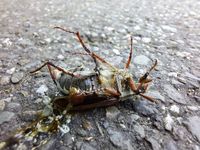Macro photography
Roadkills I
Insect life span may vary a lot: from 1 day (one day flies) to more than 12 years (cicadas, most of which, i.e. 11,5 years are spent underground in the larval stage). It is not unusual to find dead insects, in the streets, in gardens, sometimes on a plant or just below. Often males and females die naturally when eggs have been laid. Near roadsides, insects can be found that died an unnatural death: flying adults killed by cars passing by during dusk or dawn. Smaller ones are mostly splashed, bigger ones - such as scarab beetles (Scarabidae), horse flies (Tabanidae) and others - bounce off and end at the roadside. Some examples I show here of what I found when walking along the edge of roads. All insects pictured here died either a natural death or as a result of a traffic accident.
Roadkills II
Where roads and nature interfere, a specific biotope is created, but also an extra danger zone. We create tunnels, fly-overs and ecoducts where roads and highways cross nature reserves. Insects certainly are not the only creatures that are killed when crossing roads. In fact all animals that mate, live, forage, shelter near roads and try to make it to the other side, can be killed by collision with vehicles: from foxes, hares and badgers, birds and amphibians, cats and mice and rats, to snakes and even earthworms. For animals a road can be a war zone.
I sometimes stop, put them aside before they get completely run over, and now and then make a picture to witness and save their inner beauty. I still have to find a way to make a tribute to their life cut short. For this, Roadkill, a book compiled by Anders Ängsvik (2019), in which he gives some of the animals he found an afterlife, is an inspiration.
